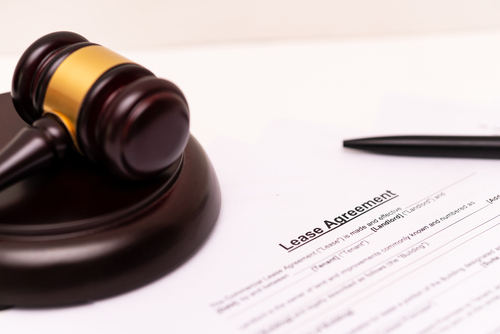The rules for forfeiting a commercial lease were amended last year to protect businesses that were badly affected or forced to close during the Covid 19 crisis. With these restrictions likely to remain in place at least until March 2022, you should be aware of your current rights as a landlord when it comes to ending the leases on commercial properties.
What is forfeiture of commercial lease?
A forfeiture of a commercial lease is another term for ending a business tenancy, specifically in a situation where a landlord peaceably regains possession of the property.
It is one of the rights a landlord holds according to The Landlord and Tenant Act, although a clause must be included in the agreed lease to allow for peaceable re-entry. This generally occurs against the wishes of a tenant due to them breaking a covenant or one of the terms of the lease.
Non-Payment of Rent and Coronavirus
Until recently, the most common cause for forfeiture was a tenant neglecting or refusing to pay their rent. Since the 16th June 2020, however, this option has been suspended for most tenancies.
Although some properties where the lease has lasted less than 6 months are able to be forfeited, in the majority of cases, legislation now protects commercial tenants who are unable to pay their rent.
This has been difficult for many landlords who have been restricted from using the tools they have historically been able to rely on in the case of nonpayment.
When the period specified by the government for the forfeiture suspension (currently extended to March 2022) comes to an end, the tenant should still be liable for the rent they have accrued, as well as any interest on that amount.
The government suggests that tenants and landlords should come to an agreement in the meantime concerning how and when the outstanding amount should be paid. After March 2022, forfeiture is likely to become an option again for landlords if commercial tenants continue to not pay their rent.
When can a landlord forfeit a commercial lease?
Depending on the wording of the lease, Landlords may still forfeit business tenancies when a tenant breaks one of the terms of the lease or a covenant unrelated to the nonpayment of rent.
This could include situations where the tenant is using the property improperly, subletting or causing a nuisance (Such as regularly making excessive noise.) However, a forfeiture clause must be included in the lease to legally allow the landlord or the landlord’s Certified Enforcement Agent to re-enter the property.
Before beginning forfeiture process, you must establish your right to forfeit and serve tenants with a Section 146 Notice. This lays out what breach has occurred and , if the breach is remediable, gives tenants a reasonable time to take action to this effect.
A Waiver of Forfeiture
A landlord can lose their right to forfeit if they have implied or expressed that they have waived this right. This can occur even when the landlord has no intention of waiving their entitlement if they do not have a proper understanding of what their actions might imply.
Anything which the tenant or their legal team could use to prove that you recognised the lease would continue can be construed as a waiver. One of the most common ways that landlords lose the right to forfeit a lease is if the landlord accepts or demands a rental payment after they learn about the tenant’s breach. Actions taken by employees of a landlord- for example, an accountant paying in a cheque from a tenant- can also be used as proof of a waiver.
Losing the Right to Forfeit a Commercial Lease
In some cases, waiving the forfeiture can mean that landlords will never again be able to make steps towards forfeiture on that lease, even in the case of further breaches. This is usually in the cases of “once-and-for-all” breaches such as changing the use of a building without permission. In other cases, such as if the tenant continually fails to upkeep the commercial property to the agreed standard, a future forfeiture may be allowed.
For the best chance at retaining your right to forfeit, all rent should be rejected after you gain knowledge of the breach and you should limit communication with your tenant and their representatives as much as possible. If you need to speak with them about the breach, stating that the conversation is “without prejudice” may give you a degree of protection.
Should you lose your right to forfeit, there are other options available to you in the case of a breach. Depending on the nature of the breach, these could include trying for a court order demanding that the tenant pay damages or applying for an injunction.
Can you forfeit a commercial lease without a forfeiture clause?
In some cases, it can be argued that forfeiture is implied in a lease without a specific forfeiture clause, but this is rare.
To ensure you have the right to forfeit, check any commercial tenancy agreements you sign for a forfeiture clause. Most will have one but you can discuss terms with your would-be-tenant or letting agent if this is not the case.
What happens when a commercial lease is forfeited?
If you serve tenants with a 146 notice and they do not remedy the breach or compensate you the amount demanded, you can move forward with the forfeiture of commercial lease procedure. This can be enacted in two different ways:
- Peaceable Re-entry
- Forfeiture Proceedings
With peaceable re-entry, a landlord or their agent enters the commercial property and secures it- usually by changing the locks while the tenant is absent- thereby regaining possession of the building. To stay on the right side of the law, this must be done peaceably. This is a quick method with minimal expenses. It also puts the responsibility on the lease holder to take further action, such as seeking relief. One disadvantage of this method is that specific processes must then be followed to handle any property or trade goods left by the tenant.
Forfeiture proceedings are when the forfeiture is enacted through the courts. This often takes longer and the results can be unpredictable.
Relief against forfeiture of commercial lease
Once forfeiture has taken place, a commercial lessee or a third party with interest can apply to the court for relief against forfeiture. The court will generally grant relief if the tenant pays compensation or remedies the original breach and the court believes that they will uphold the terms of their lease in the future. The court may also choose to put conditions on the relief being granted.
If relief if granted, you and your commercial tenants will both be back under the terms of your lease and the tenant should regain entry to the building. A landlord and tenant cannot negotiate forfeiture relief out of court.
How much does forfeiture of commercial lease cost in the UK?
The cost of forfeiture depends on how the forfeiture was carried out and whether you sought legal or professional assistance. If you hire a bailiff or other agent to peaceably re-enter the property and liaise with the tenant as to what happens to their belongings or trade goods, they may charge up to £400.
If you plan to re-enter the property yourself, you will avoid this cost but will still have to pay to secure the property. Legal fees will vary if you seek assistance in serving notices or achieving the result you want through forfeiture proceedings.
Forfeiting the lease on a commercial property also means running the risk of paying rates on the property on top of loosing revenue through rent, so make sure you have a full understanding of your situation from the start.
Able Enforcements is one of the leading Enforcement companies within the UK. We act on a number of projects from the enforcement of a Writ to dealing with problem tenants, we can visit your tenant discuss the situation with them and come to a suitable repayment plan. Ensuring that your repayments are met and collected on time every time.





Comments are closed.